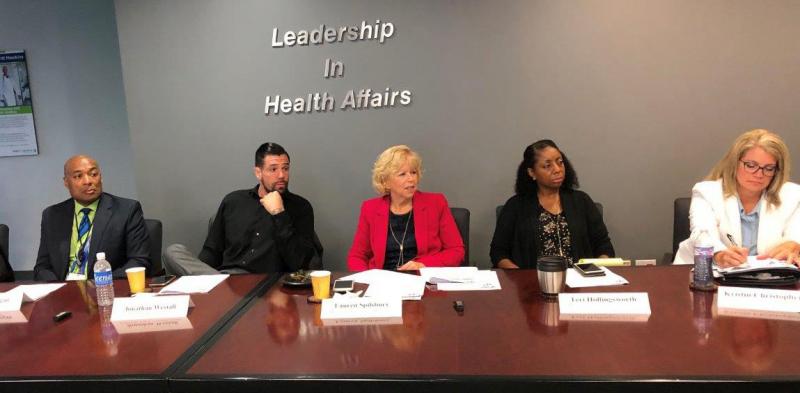HASC Partners Identify Key Violence Prevention Steps

Members of HASC’s Nursing Advisory Council and Security and Safety Committee joined for the groups’ June 7 special meeting. From left are Huntington Hospital’s Darren Morgan, Martin Luther King, Jr. Community Hospital’s Jonathan Westall (Security and Safety Chair), Redlands Community Hospital’s Lauren Spillsbury (NAC Chair), HASC’s Teri Hollingsworth, and Fountain Valley Regional Hospital and Medical Center’s Kristin Christophersen.
______________________________________________________________________________
Close to 40 members of HASC’s Nursing Advisory Council (NAC) and Security and Safety Committee met June 7 to discuss how hospitals can limit workplace violence. The session produced key takeaways, listed below, on steps facilities can take to keep dangerous and unpleasant incidents to an absolute minimum.
NAC Chair Lauren Spilsbury, chief nursing officer at Redlands Community Hospital, joined security and safety chair Jonathan Westall of Martin Luther King, Jr. Community Hospital in opening the meeting with an overview of the workplace violence landscape in Southern California.
Stephanie Wilcher, senior vice president of operations and patient services at Beverly Hospital, Darren Morgan, director of security, Huntington Hospital, Shannon McDougal, regional director of health care operations, Allied Universal, and Gail Blanchard-Saiger, vice president of labor and employment with California Hospital Association, were also on the agenda.
Participants reported the following key take-aways from the discussion:
- Strengthen collaboration between security, nursing and administration to improve visibility of the issue, improve documentation, develop best practices and measure ability to effect change.
- Train the entire workforce on de-escalation tactics and early identification of aggressive behavior.
- “See something, say something.” Growing a safe and secure culture is everyone’s responsibility.
- Security employees are expected to be regarded as a member of the clinical team; nursing and all clinical staff expected to be regarded as a member of the security team.
- “As leaders, we must provide the support our employees need.”
- Zero tolerance is a platform to improve employee safety.
- Develop a BERT, Behavioral Emergency Response Team, as part of hospital operations.
- Strengthen the hospital’s visitor management program.
- Add workplace safety, awareness and personal safety to nursing, medical and clinical curriculum.
Learn more about workplace violence prevention via the following HASC site pages.
- HASC Endorsed Business Partner and workplace violence prevention training provider HSS Inc.
- HASC’s Inland Region Workplace Violence Prevention Taskforce.
- HASC active shooter drill materials page.
Contact:
Teri Hollingsworth
(213) 538-0763
thollingsworth@hasc.org



